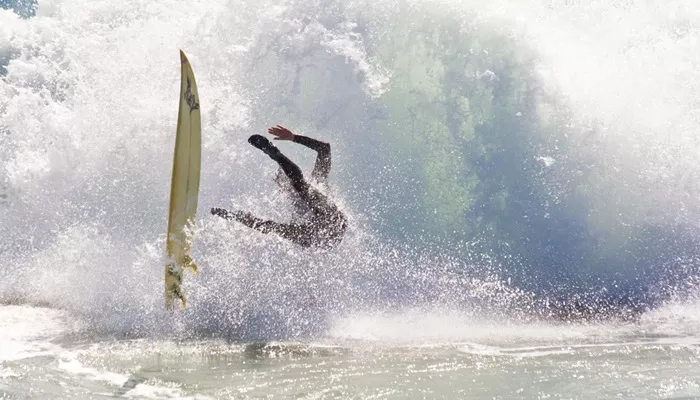One of the biggest challenges longboard surfers face is getting through breaking waves while paddling out. Unlike shortboarders who can use the duck dive to sink their board under waves, longboarders must rely on a different technique: the turtle roll. Mastering the turtle roll is crucial for efficiently navigating whitewater and breaking waves while maintaining control of your board.
The turtle roll is an essential skill that allows longboarders to get past waves without being pushed backward or losing too much energy. It involves flipping the board upside down and submerging beneath the wave to reduce resistance. While the technique is relatively simple, executing it effectively requires proper timing, positioning, and control.
In this guide, we will break down the turtle roll technique, discuss common mistakes, and provide training tips to help you improve your execution. Whether you’re a beginner or an intermediate surfer looking to refine your skills, this article will help you develop a strong and reliable turtle roll.
Understanding the Importance of the Turtle Roll
Before diving into the mechanics of the turtle roll, it’s essential to understand why this technique is so important for longboard surfers.
Why Longboarders Can’t Duck Dive
Longboards have significantly more volume and buoyancy compared to shortboards, making it impossible to sink them under waves like shortboards do.
The turtle roll allows longboarders to submerge beneath waves without losing their board or getting pushed back too far.
Learning how to turtle roll properly ensures smoother paddling out and better positioning in the lineup.
When to Use the Turtle Roll
When paddling out and facing incoming whitewater or breaking waves.
When a wave is too powerful to push through with momentum alone.
In situations where a wave is breaking directly in front of you and you need to minimize resistance.
Step-by-Step Guide to Performing a Turtle Roll
To execute a successful turtle roll, follow these key steps:
Step 1 – Assess the Incoming Wave
Identify when and where the wave is going to break.
Time your turtle roll so you flip just before the wave reaches you.
Ensure you have enough momentum to control the roll effectively.
Step 2 – Grip Your Board Correctly
As the wave approaches, grab both rails (sides of the board) firmly near the middle.
Keep your arms slightly bent to absorb any impact from the wave.
Ensure your grip is strong enough to keep the board close to your body.
Step 3 – Flip the Board Upside Down
Roll yourself and your board over so that the board’s fins are facing upward and you are underwater.
Use your body weight to control the board and prevent it from being ripped out of your hands.
Keep your arms extended to maintain stability.
Step 4 – Position Your Body Underwater
Keep your body streamlined to minimize resistance against the wave.
Avoid kicking or making unnecessary movements, as this can destabilize you.
Stay calm and composed as the wave passes over.
Step 5 – Flip Back Over and Resume Paddling
Once the wave has passed, flip your board right side up by rolling back over.
Quickly reposition yourself on the board and start paddling immediately to maintain momentum.
Keep an eye on the next wave to determine if another turtle roll is necessary.
Common Mistakes and How to Avoid Them
Many beginners struggle with the turtle roll due to improper execution. Here are some common mistakes and how to fix them:
Flipping Too Early or Too Late
Issue: If you roll too early, the wave may pull the board out of your hands. If you roll too late, you may get hit before you submerge.
Solution: Time your roll so you flip just before the wave reaches you, ensuring you’re submerged when the wave passes.
Weak Grip on the Rails
Issue: Losing grip on your board can cause it to get pushed back or even hit you.
Solution: Maintain a firm grip on both rails and use your body weight to stabilize the board.
Poor Body Positioning Underwater
Issue: If you’re too tense or flailing, you may struggle to control the board.
Solution: Stay relaxed and streamlined under the wave to reduce drag.
Not Paddling Quickly After Flipping Back
Issue: Hesitating after flipping back can make it harder to regain momentum.
Solution: Start paddling immediately to move forward and avoid getting caught by the next wave.
Training Drills to Improve Your Turtle Roll
Improving your turtle roll requires practice both in and out of the water. Here are some drills to help:
Pool or Calm Water Practice
Find a calm body of water (pool, lake, or bay) to practice flipping your board over and back.
Work on gripping the rails properly and controlling the roll.
Paddle Strength Training
Strengthen your paddling muscles with push-ups, pull-ups, and lat pulldowns.
Improve endurance by swimming and doing resistance paddling drills.
Controlled Wave Practice
Start in small, manageable waves to practice your timing and execution.
Gradually move to larger waves as your confidence improves.
Alternative Techniques for Getting Through Waves
While the turtle roll is the primary technique for longboarders, other methods can help in different situations:
Punching Through Whitewater
If the wave is small, you can power through it by maintaining strong paddling momentum.
Using an Angle to Navigate Waves
Instead of taking waves head-on, paddling at an angle can help you avoid the full impact.
Conclusion
The turtle roll is a vital technique for longboard surfers, allowing them to navigate breaking waves efficiently without losing control. By mastering the correct timing, grip, and positioning, you can significantly improve your ability to paddle out and reach the lineup with ease.
Regular practice, strength training, and refining your technique will make the turtle roll second nature. Implement these strategies in your next surf session, and you’ll find yourself paddling out with more confidence and efficiency. Keep practicing, stay patient, and enjoy the ride!

